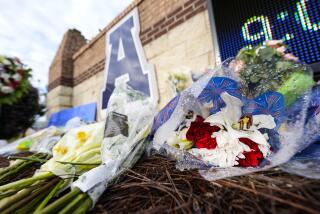Youth’s 911 Call Eerie Precursor to Police Killing
- Share via
Moments before killing a rookie police officer, 17-year-old Christopher Golly called 911 to say he had just killed his father and that, “I’ll see you when you get here,” according to a dispatcher’s tape released Friday.
In a chilling precursor of the bloody ambush to follow, Golly ignored a dispatcher’s repeated requests to put his gun down and stay on the phone until police arrived.
Golly’s call came immediately after a call from a woman who had been in the house and had taken a cellular phone outside.
When police arrived at Golly’s Northridge house about 1:20 a.m. Tuesday, the troubled methamphetamine user was already hiding outside with a loaded AR-15 assault rifle. He sprayed the three squad cars with bullets, killing rookie Officer Christy Lynne Hamilton, 45, with one shot that pierced her chest above her bullet-proof vest.
Police said the tape reinforces statements that Golly made to a friend hours before the shooting: that he planned to kill his father and then ambush those officers responding to the crime scene and “take out” several.
“In hindsight, knowing what we know now. . .it appears very ominous,” said Police Lt. John Dunkin. “Knowing now everything that went on, his conversation with his friend, it lends a different meaning of, ‘I’ll see you when you get here.’ It’s almost eerie.”
Until Friday, police had not disclosed the existence of the 911 call.
But even in light of indications on the tape that an armed and uncooperative killer may have been waiting for them, police officials said they had no idea of the troubled teen-ager’s intentions to open fire. And they continued to defend the tactics of the officers responding to the scene, who inadvertently pulled up right in front of the Golly house on Amestoy Avenue and made Hamilton a vulnerable target.
On the tape, the 911 operator can be heard saying “use caution, victim and suspect are still at the scene. Suspect is still armed.”
Dunkin said officers were aware that someone had been shot at the house, and that an armed gunman could still be there. He said officers followed correct tactical procedure, which is to stop several houses away and assess the situation before acting or calling in a Special Weapons and Tactics unit.
“If they stopped a block away and walked there, maybe this wouldn’t have happened,” Dunkin said. “But that isn’t the way you answer radio calls.”
Dunkin, like other police officials, said Hamilton’s slaying was the result of several factors that were out of the control of the responding officers. It was too dark to see the numbers on the houses, police said, and the Golly home was on a corner, despite the fact that the address led officers to expect to find it in the middle of the block, where they saw a woman waving to them.
In addition, a police helicopter that could have spotted Golly hiding behind a brick wall was grounded due to high winds, he said.
“Every officer wants to make it home at night. Who in their right mind would pull up right in front of a house where there is a guy inside with a gun?” Dunkin asked. “They certainly did not do that intentionally.”
“Absolutely,” Dunkin said, “the officers did the best job they possibly could armed with the information they had.”
Sgt. Michael Albanese, a supervisor within the LAPD’s SWAT unit, confirmed that according to LAPD policy, SWAT members would only be called after patrol officers responded and verified that a gunman actually was inside a house.
After patrol officers were deployed and after Hamilton was shot--Albanese and other SWAT members were called to the scene, said Albanese. Shortly before 6 a.m., SWAT members fired tear gas canisters into the house and entered the house and found the bodies of Golly, who had fatally shot himself, and his father, Steven.
During the 911 call, Golly appeared to be playing with a dispatcher as he told her what he had done.
“Uh, yes, I’d like to report a murder,” he said. What happened, she asks.
“I shot my dad,” he said, adding that he thought “it would be nice” to shoot him.
When asked where the gun was he said “It’s. . .on my shoulder right now.”
The dispatcher asked him to put the gun down. Golly responded, “Nah.”
Later, a paramedic is patched into the call.
“Put the phone down, I mean put the gun down. . .we’re not playing around,” the Fire Department official said after several minutes. “Right,” Golly responded.
After Golly said, “I’ll see you guys,” the operator asked him to stay on the line and to put the gun where police could see it.
“Nah,” Golly replies again, “I’ll see you guys when you get here.”
“No, no, no, Chris?” the operator asks. But by then, Golly had hung up.
Police said Golly then went to the side of the house, and waited.
Hamilton stopped her squad car behind two other police vehicles on Septo Street, which intersected with Amestoy Avenue in front of Golly’s house. Although it wasn’t clear if Golly had fired any shots before she left the car, Hamilton was crouching behind her door and reaching for a Rover portable police radio when she was shot, her father said Friday.
Kenneth Brondell, Hamilton’s father, said he has talked to his slain daughter’s partner about what transpired early that morning. Brondell, a 30-year veteran of the LAPD, said his daughter had put herself at risk by responding to the call, doing what officers are trained to do.
“Even if someone is lying there in wait, the officers can’t stand a block away and wait. Someone has to move up. It just has to be done,” Brondell said Friday.
“What good would it do to call the police if they stayed a long way away for safety? He might have killed somebody else--after all, he already killed his father,” Brondell said. “If there are chances that have to be taken that are absolutely necessary, then police have to take them. They can’t stand back and hide.”
Excerpts of Call
Operator/female: Hello
Caller/male: Uh, yes, I’d like to report a murder?
Operator: Where did this happen?
Caller/male: Uh, 9930 Amestoy.
Operator: What happened?
Caller/male: I shot my dad.
Operator: Hold on. Is he--when did you do this?
Caller/male: Oh, about five minutes ago.
Operator: Hold on. (dial tone) Is he not breathing there? At all?
Caller/male: Uh, yes.
Operator: Where’s the gun right now? (2nd call picks up)
Fire Dept. Paramedics/male: “Fire Department Paramedics, 82.”
Operator: Paramedics, think you’re already going, this is at 9930 Amestoy, guy says he’s dead. So we have the suspect on the phone here.
Fire Dept.: Check here.
Caller/male: I just thought it would be nice to shoot . . . dad (garbled)
Fire Dept.: Shooting?
Operator: Yeah. So--
Fire Dept.: We’re going.
Operator: OK. Well, use caution, suspect’s still there.
Fire Dept.: OK, the suspect’s still there?
Operator: Yeah, we got him on the phone here. Sir, where’s the gun right now?
Caller/male: It’s . . . on my shoulder right now.
Operator: OK, why don’t you put the gun down?
Caller/male: Nah.
Fire Dept.: Why is--what is he doing with the, with the gun?
Caller/male: Oh, I shot him.
Fire Dept.: You’re the one who did the shooting, sir?
Caller/male: Yeah.
Fire Dept.: All right, this is what you need to do, OK?
Caller/male: Uh-huh.
Fire Dept.: Put the phone down, I mean put the gun down.
Caller/male: OK.
Operator: 7 Hale 30, I have the P.O. on the phone, he’s still armed with the gun.
Fire Dept.: All right?
Caller/male: Yeah.
Fire Dept.: We’re not playing around.
Caller/male: Right.
Fire Dept.: Do you have the gun? Where’s the gun at?
Caller/male: On my shoulder.
Fire Dept.: On your shoulder?
Caller/male: Yes.
Fire Dept.: All right, well, what’s it doing on your shoulder?
Caller/male: Oh, it’s (just the??) strap, it’s . . .
Male voice: 81, we’ll be there in about six minutes.
Fire Dept.: OK, well, let’s put the gun where the police and the fire department can see it, OK?
Operator: 81, (garbled) 9930 Amestoy (garbled) be advised (garbled) unable to respond due to high winds.
Male voice: Hey, he’s got a gun out, so . . .
Operator: What’s your name?
Caller/male: Chris.
Operator: Chris. Who else is at home?
Caller/male: Ummm, no one. I took--I sent them all out.
Fire Dept.: OK . . . thanks.
Operator: OK, bye bye. OK, Chris?
Caller/male: I’ll see you guys--
Operator: No, I want you to stay on the phone with me, OK? Because--
Caller/male: Nah, I’ll see you guys when you get here.
Operator: No, no, no, Chris?
(Chris hangs up)
More to Read
Sign up for Essential California
The most important California stories and recommendations in your inbox every morning.
You may occasionally receive promotional content from the Los Angeles Times.









